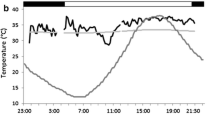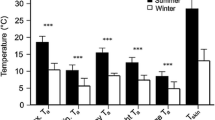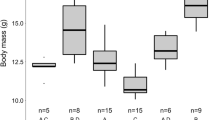Summary
The insectivorous bat Myotis lucifugus typically apportions the night into two foraging periods separated by an interval of night roosting. During this interval, many bats occupy roosts that are used exclusively at night and are spatially separate from maternity roosts. The proportion of the night which bats spend roosting, and thus the proportion spent foraging, vary both daily and seasonally in relation to the reproductive condition of the bats, prey density, and ambient temperature. A single, continuous night roosting period is observed during pregnancy. During lactation, females return to maternity roosts between foraging bouts, and night roosts are used only briefly and sporadically. Maximum use of night roosts occurs in late summer after young become volant. Superimposed upon these seasonal trends is day-to-day variation in the bats' nightly time budget. Long night roosting periods and short foraging periods are associated with cool nights and low prey density. This behavioral response may minimize energetic losses during periods of food scarcity.
Similar content being viewed by others
References
Anthony ELP, Kunz TH (1977) Feeding strategies of the little brown bat, Myotis lucifugus, in southern New Hampshire. Ecology 58:775–786
Bell GP (1980) Habitat use and response to patches of prey by desert insectivorous bats. Can J Zool 58:1876–1883
Bidlingmayer WL (1964) The effect of moonlight on the flight activity of mosquitoes. Ecology 45:87–94
Bowden J, Church BM (1973) The influence of moonlight on catches of insects in light-traps in Africa. Part II. The effect of moon phase on light-trap catches. Bull Ent Res 63:129–142
Buchler ER (1980) The development of flight, foraging, and echolocation in the little brown bat (Myotis lucifugus). Behav Ecol Sociobiol 6:211–218
Cockrum EL, Cross SP (1964) Time of bat activity over water holes. J Mammal 45:635–636
Cross SP (1965) Roosting habits of Pipistrellus hesperus. J Mammal 46:270–279
Dalquest WW (1947) Notes on the natural history of the bat, Myotis yumanensis, in California, with a description of a new race. Amer Midland Nat 38:224–247
Davis WH, Barbour RW, Hassell MD (1968) Colonial behavior of Eptesicus fuscus. J Mammal 49:44–50
el-Ziady S (1957) A probable effect of the moonlight on the vertical distribution of Diptera. Bull Soc Entom Egypte 41:655–662
Erkert HG (1974) Der einfluß des Mondlichtes auf die Aktivitätsperiodik nachtaktiver Säugetiere. Oecologia (Berl) 14:269–287
Fenton MB, Fleming TH (1976) Ecological interactions between bats and nocturnal birds. Biotropica 8:104–110
Gillette DD, Kimbrough JD (1970) Chiropteran mortality. In: BH Slaughter, DW Walton (eds), About bats: a chiropteran symposium. Southern Methodist Univ Press, Dallas p 262–283
Hirshfeld JR, Nelson ZC, Bradley WG (1977) Night roosting behavior in four species of desert bats. Southwestern Nat 22:427–433
Jones C (1965) Ecological distribution and activity periods of bats of the Mogollon Mountains area of New Mexico and adjacent Arizona. Tulane Studies Zool 12:93–100
Kleinbaum DG, Kupper LL (1978) Applied regression analysis and other multivariable methods. Duxbury Press North Scituate, Massachusetts
Krutzsch PH (1954) Notes on the habits of the bat, Myotis californicus. J Mammal 35:539–554
Kunz TH (1973) Resource utilization: temporal and spatial components of bat activity in central Iowa. J Mammal 54:14–32
Kunz TH (1980) Daily energy budgets of free-living bats. In: DE Wilson, AL Gardner (eds), Proceeding: Fifth International Bat Research Conference. Texas Tech Press Lubbock p 369–392
Kunz TH, Anthony ELP (in press) Age estimation and post-natal growth in the bat Myotis lucifugus. J Mammal
Kunz TH, Stack MH, Anthony ELP (in preparation) Energy of bats conserved by night roosting in small cavities.
Morrison DW (1978) Lunar phobia in a neotropical fruit bat, Artibeus jamaicensis (Chiroptera: Phyllostomidae). Anim Behav 26:852–855
Norberg RÅ (1977) An ecological theory on foraging time and energetics and choice of optimal food-searching method. J Anim Ecol 46:511–529
Nyholm ES (1965) Zur Ökologie von Myotis mystacinus (Leisl.) und M. daubentoni (Leisl.) (Chiroptera). Ann Zool Fenn 2:77–123
O'Farrell MJ, Bradley WG (1970) Activity patterns of bats over a desert spring. J Mammal 51:18–26
O'Shea TJ, Vaughan TA (1977) Nocturnal and seasonal activities of the pallid bat, Antrozous pallidus. J Mammal 58:269–284
Pyke GH, Pulliam HR, Charnov EL (1977) Optimal foraging: a selective review of theory and tests. Quart Rev Biol 52:137–154
Reith CC (1980) Shifts in times of activity by Lasionycteris noctivagans. J Mammal 61:104–108
Rosenzweig ML (1974) On the optimal aboveground activity of bannertail kangaroo rats. J Mammal 55:193–199
Rumage WT III (1979) Seasonal changes in dispersal pattern and energy intake of Myotis lucifugus. MA Thesis, Boston University
Schoener TW (1971) Theory of feeding strategies. Ann Rev Ecol Syst 2:369–404
Swift SM (1980) Activity patterns of Pipistrelle bats (Pipistrellus pipistrellus) in north-east Scotland. J Zool, Lond 190:285–295
Taylor LR (1951) An improved suction trap for insects. Ann Appl Biol 38:582–591
Thomas SP (1975) Metabolism during flight in two species of bats, Phyllostomus hastatus and Pteropus gouldii. J Exp Biol 63:273–293
Trillmich F, Mohren W (1981) Effects of the lunar cycle on the Gal'apagos fur seal, Arctocephalus galapagoensis. Oecologia (Berl) 48:85–92
Turner DC (1975) The vampire bat: a field study in behavior and ecology. Johns Hopkins Univ Press Baltimore
Vaughan TA, O'Shea TJ (1976) Roosting ecology of the pallid bat, Antrozous pallidus. J Mammal 57:19–42
Williams CB (1936) The influence of moonlight on the activity of certain nocturnal insects, particularly of the family Noctuidae, as indicated by a light trap. Phil Trans Roy Soc Lond B 226:357–389
Williams CB (1940) An analysis of four years captures of insects in a light trap. Part II. The effect of weather conditions on insect activity; and the estimation and forescasting of changes in the insect population. Trans Roy Ent Soc Lond 90:227–306
Williams CB, Singh BP (1951) Effect of moonlight on insect activity. Nature 167:853
Williams CB, Singh BP, el-Ziady S (1956) An investigation into the possible effects of moonlight on the activity of insects in the field. Proc Roy Ent Soc Lond A 31:135–144
Author information
Authors and Affiliations
Rights and permissions
About this article
Cite this article
Anthony, E.L.P., Stack, M.H. & Kunz, T.H. Night roosting and the nocturnal time budget of the little brown bat, Myotis lucifugus: Effects of reproductive status, prey density, and environmental conditions. Oecologia 51, 151–156 (1981). https://doi.org/10.1007/BF00540593
Issue Date:
DOI: https://doi.org/10.1007/BF00540593




